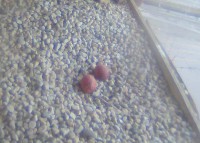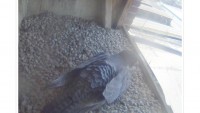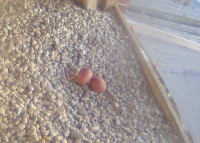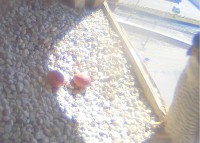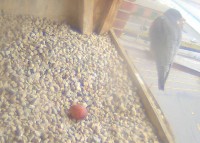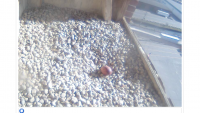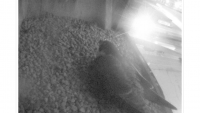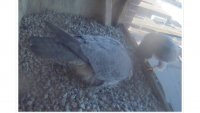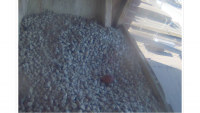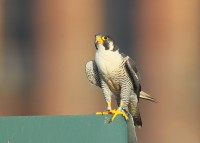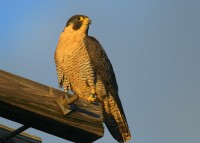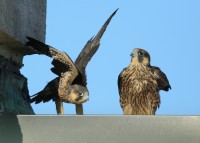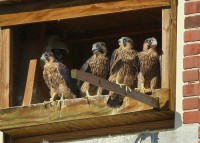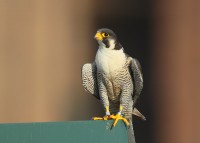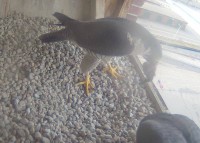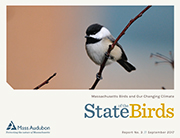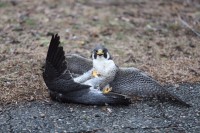 A Falcon Soars Above Lawrence for 16 Years, Then Falls To A Rival
A Falcon Soars Above Lawrence for 16 Years, Then Falls To A Rival
‘The end of a long and impressive legacy’
By Keith Eddings at The Eagle Tribune
LAWRENCE — He was first named “Crash,” for his clumsy landings as a weeks-old peregrine falcon fledgling with three siblings from their nest atop what is now the Brady Sullivan Tower in Manchester, New Hampshire, in 2001.
The four were the first of their species known to have fledged from a downtown urban setting in that state, making the event notable enough that it was covered by a local newspaper.
Crash – he was soon renamed Black6/Green4 for the colors and numbers that identified him on his leg band – was the weakest and not expected to survive. But he showed up in Lawrence a year later, met a female and made a home in an abandoned nest built by red-tailed hawks on an empty tray that had held an air conditioner on the sixth floor of the New Balance building on South Union Street. The pair eventually moved up to the clock tower over the building, formerly the Ayer Mill, where they became favorites among local birdwatchers and state wildlife officials, in part for their prolific breeding.
Black6/Green4 and the female fledged 32 chicks over a dozen years in downtown Lawrence, taking a giant step for wildlife in a dense urban environment by contributing significantly to a species that was on the federal endangered species list for 30 years. Peregrines were removed from the list just two years before Black6/Green4 was born, after a recovery that began when the federal government banned DDT, the pesticide that softened the shells of the eggs laid by falcons, hawks and eagles, causing them to crack.
The female died in 2015, at 14 years old. Another female soon took her place in the clock tower nest. The new pair had another 10 chicks over three years. Another of their annual clutches had been anticipated this spring, which would have given peregrines another foothold toward recovery.
That hope ended on March 30, when Black6/Green4 left his nest to hunt for the pigeons and songbirds that are among peregrines’ favorite meals. His hunt took him to a yard on Waverly Road in North Andover, where he was confronted by a much younger peregrine that may have been stalking him for days and even visited his nest in the clock tower, state wildlife officials suspect.
Feathers flew.
“It was the unrecognizable screeches that brought us outside,” said Elizabeth Carlson, who witnessed the attack on her lawn with her son, Robert, a professional photographer who took pictures of it. “The birds were the same size, but the younger clearly the advantage…. Growing up around all sorts (of animals) I have never seen such aggression.”
The younger bird flew off when the Carlsons and two others approached but quickly resumed the attack, swooping down from surrounding trees and between the four people, who were standing just feet apart. Carlson said the swoops were “a little unnerving” and said the determined look on the younger peregrine’s face suggested he was asking, “You want to be next?”
The attack lasted 20 minutes. The younger peregrine flew off, leaving Black6/Green4 mortally wounded. He remained on the lawn for 20 minutes more and was able to fly off when the Carlsons attempted to place him in a box so they could deliver him to a wildlife rescue clinic.
Two days later, another homeowner found him lying in his yard in Amesbury, about 15 miles from where he was attacked. The homeowner was able to place him in a parakeet cage and posted his picture on Facebook. A New Hampshire falconer saw the picture and contacted Massachusetts falconer Wendy Pavlicek, who picked him up and delivered him Monday morning to the Tufts Wildlife Clinic in North Grafton, operated by Tufts University’s Cummings School of Veterinary Medicine.
News of the attack and the attempt to rescue Black6/Green4 spread quickly among the scores of birders in the region who have followed his life in Lawrence, including Tom French, the assistant director of the state Division of Fisheries and Wildlife responsible for the division’s endangered species program. To protect Tufts from being overwhelmed with phone calls and emails seeking to learn the peregrine’s fate, French sent out an email declaring himself the point person between the birders and the rehab center.
“He is in very poor shape,” French said in an email to the birders Monday. “He is severely emaciated and very depressed, so he is now being kept in an oxygen cage. He has bruises and talon punctures, but apparently no broken bones.”
A few hours later, French sent another email.
“I just learned from the Tufts Wildlife Clinic that the 17-year-old male Peregrine Falcon, 6*/4* from Lawrence just died,” he wrote. “This is not a surprise, but it is the end of a long and impressive legacy.”
By then, the bird that attacked and killed Black6/Green4 had moved into his nest and copulated with his mate.
On Thursday, she laid her first egg. She laid another Friday night. One or two more are expected to follow over the next few days.
It was a Shakespearean end to Black6/Green4’s life, straight from the pages of “Hamlet.” But his fate is common among peregrines, French said Friday.
“That’s the way it works,” he said. “The old-fashioned concept (of how peregrines meet and mate) is that a young male and a young female settle into a place to reproduce. In reality these days, a lot of the best places already are taken. So a hostile takeover is more common. When they get to breeding age and move around looking for a place, they find one that has an established pair and kill the member of the pair that’s the same sex. If they succeed, they inherit the mate, the nest and all the territory that goes with it.”
Females will attack females with the same purpose that males attack males, French said.
At 17, Black6/Green4 was the second oldest peregrine ever recorded in Massachusetts, French said. The oldest disappeared at 19 and was never found. Their average lifespan is 10 years.
The Lawrence falcon’s long life and the 42 chicks he produced with the two females is a landmark event in the peregrine’s more than half-century of recovery nationwide, including when they went extinct first in Massachusetts in 1955 and then the entire eastern United States. The first returned to Massachusetts in 1987. Today, there are 48 known pairs in the state.
“Peregrines are one of the icons, the poster children,” of the recovery all raptors have made since the pesticide DDT was banned in 1972, French said. “There are a lot of superlatives to describe them. They’re the fastest animal in the world. The fastest measured at 242 mph in a dive. They’re (unique) in their design and engineering and they’ve been marveled at since the kings and princes of falconry in the Middle Ages. They have a lot of history to go with them.”
Craig Gibson, the Roman Catholic chaplain at Lawrence General Hospital, had been observing Black6/Green4 in the sky above Lawrence since in November 2011. He said the bird’s life in the city is replicated daily on the streets below.
“It’s a fascinating story, right in our backyard,” Gibson said. “Here you have a 17-year-old male who was the runt of the litter. It didn’t look like (when he fledged) up in Manchester that he would make it. So he’s an incredible survival story in a city where there are many who against all odds find their way to success.”
Black6/Green4 survival story includes this: He outlived his three siblings and most of his fledglings, whose fate is known because they were tagged, according to records French described in his emails to the other birders last week.
Among his fledglings, a female was killed when she flew into the Travelers Tower in Hartford while chasing a pigeon in 2003. A male with severe bumblefoot – a bacterial infection of the feet – was euthanized after he showed up in the backyard of a pigeon racer in 2004. Another female was hit by a car on Nantucket in 2009. A male living above Fox Hall at UMass Lowell lost an eye from a shotgun pellet in 2016 and was euthanized a few months later after he was found emaciated at Governor’s Academy in Newbury. Another male was euthanized in 2016 after he was struck by a plane at Logan International Airport.
Against these odds, Black6/Green4’s former mate and the young male who is taking his place in the clock tower above New Balance are expected to hatch their chicks late in May.
To see a live webcam of Black6/Green4’s nest, where his former mate is incubating eggs fathered by her new mate, visit http://lawrenceperegrines.com/, then click on “New Balance Falcon Cam”
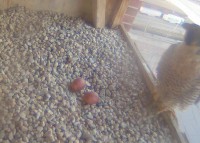 Today may be the day that the female lays her third egg! The second egg was laid Saturday in the middle of the day, and typically the female will lay eggs about 48 hours apart. Today the female woke up to clear skies, and winds from the west at 10MPH, and temperature around 30F. The wind chill was around 21F and with the wind blowing from the west, she felt the chill and spent lots of time incubating the eggs and protecting them from the cold. She did spend time perched at edge of nest box and on the outer perch pole.
Today may be the day that the female lays her third egg! The second egg was laid Saturday in the middle of the day, and typically the female will lay eggs about 48 hours apart. Today the female woke up to clear skies, and winds from the west at 10MPH, and temperature around 30F. The wind chill was around 21F and with the wind blowing from the west, she felt the chill and spent lots of time incubating the eggs and protecting them from the cold. She did spend time perched at edge of nest box and on the outer perch pole.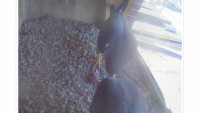 Late in the morning, the male arrived in the nest box with prey and it was a joy to watch them engage in pair bonding as a new pair, and watch them in a classic food exchange. The photo shows the males with back to camera and the female facing the camera. By this time the temps had moved up a bit, but the wind chill at 27F, made the air still feel quite cold.
Late in the morning, the male arrived in the nest box with prey and it was a joy to watch them engage in pair bonding as a new pair, and watch them in a classic food exchange. The photo shows the males with back to camera and the female facing the camera. By this time the temps had moved up a bit, but the wind chill at 27F, made the air still feel quite cold.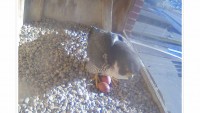 By late in the afternoon, the temps had warmed up to mid-forties, with wind chill just above 40F. The wind remained fairly steady and continued from the west at 10MPH. The female spent time hovering over the eggs, rather than squatting low in incubation posture. It seemed like she might be ready to lay another, but turns out, not just yet!
By late in the afternoon, the temps had warmed up to mid-forties, with wind chill just above 40F. The wind remained fairly steady and continued from the west at 10MPH. The female spent time hovering over the eggs, rather than squatting low in incubation posture. It seemed like she might be ready to lay another, but turns out, not just yet!